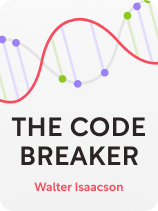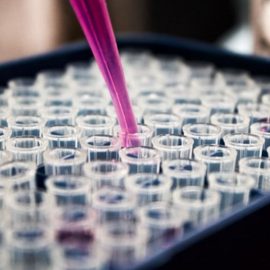

This article is an excerpt from the Shortform book guide to "The Code Breaker" by Walter Isaacson. Shortform has the world's best summaries and analyses of books you should be reading.
Like this article? Sign up for a free trial here.
Is it ethical to edit the genes of future generations? What are the potential benefits and risks of germline editing?
Germline editing ethics is a complex and controversial topic. Scientists and philosophers debate the morality of altering DNA that can be passed down to future offspring. In The Code Breaker, Walter Isaacson shares arguments for and against this practice.
Keep reading to explore the nuanced perspectives on this cutting-edge technology and its implications for humanity’s future.
The Ethics of Germline Editing
Isaacson says that most people think it’s morally OK to edit somatic cells—non-reproductive cells that affect only an existing person’s bodily composition. But people disagree about whether it’s OK to edit germline cells, which include eggs and sperm. When you edit germline cells, you genetically modify potential future offspring, and the changes you make could be inherited by their offspring as well. Isaacson describes a few opinions on each side of the debate related to germline editing ethics.
Some people who are against germline editing argue that it’s wrong because it’s heretical or unnatural—either God or nature (via evolution) designed our genes the way they are for a reason, so humans shouldn’t interfere. Isaacson says this argument may not be logical: If nature or God endowed us with the ability to develop and use CRISPR, then using it can’t be unnatural or heretical. He also notes that genes aren’t distributed fairly—some people suffer more than others for no reason other than the luck of the genetic draw—and we may be morally obligated to even the playing field. However, Isaacson recognizes some existential risks of germline editing: We might develop hubris and become ungrateful for what nature or God gave us.
Some people who are in favor of germline editing argue that we have a moral duty to set our children up for success. Philosopher Julian Savulescu calls this stance “procreative beneficence.” Isaacson says that germline editing would accomplish this goal more efficiently than somatic editing. To illustrate, consider the blood disorder called sickle cell disease: Somatic edits can cure individuals, but germline edits could prevent their descendants from developing sickle cell disease in the first place. Theoretically, this would improve human life by leaps and bounds. But there’s also a downside to making germline edits—we might decrease genetic diversity, which is an evolutionary disadvantage.
| Weighing Both Sides of the Germline Debate Isaacson explains that many arguments could be made to justify taking either side of the germline debate. Let’s explore those arguments in more detail now. Isaacson says some people believe germline gene editing is heretical or unnatural, but that this is illogical because we are endowed with the ability to do so using CRISPR. Another objection to this argument is that while CRISPR germline gene editing would involve purposefully changing our children’s DNA, it’s not unique—we already make mundane choices that have bearing on our children’s genes every day. For example, we choose mates by subconsciously evaluating their genes, effectively curating the gene pool from which our children’s genes will be derived. We also engage in behaviors with epigenetic effects—effects on how our genes, and sometimes our children’s genes, will be expressed. Smoking, for example, may be associated with inherited epigenetic susceptibility to respiratory problems. Although these cases are obviously different from making direct changes to our children’s DNA, they demonstrate that it’s probably not unnatural or heretical to determine our children’s genes, since we already do so unwittingly every day. Isaacson suggests we might be morally obliged to correct harmful genetic abnormalities, but this leads to another important question—who decides what qualifies as a problem to be fixed? Some experts are worried that even if that question is decided by the court of public opinion, the answer could result in a phenomenon called “velvet eugenics.” Velvet eugenics occurs when market forces, like the relatively higher cost of raising a child with Down syndrome, influence families to make reproductive choices that prevent the birth of children with genes they determine undesirable (like the mutations that cause Down syndrome). Velvet eugenics differs from traditional eugenics programs, which tend to be state-sponsored, but may have similarly racist and ableist ends. The fear of velvet eugenics underlies major arguments against Savulesco’s standard of procreative beneficence. Additionally, CRISPR may not even be the best way to accomplish procreative beneficence, since CRISPR germline edits can result in DNA breakage and chromosomal losses, which may create new harmful genetic abnormalities without solving the original problem. But since scientists are continually working toward solutions to safety issues, these concerns may not always stand. |
Interventions vs. Enhancements
Isaacson says that scientists aren’t likely to abandon germline editing research, so society must determine under what conditions germline editing should occur. He describes a continuum of conditions that are under heavy debate by experts in the field. Many people believe germline editing is only OK when it serves as a medical intervention (with sickle cell, for example). They don’t believe it’s OK to unnecessarily enhance germline cells (like editing genes to make children conventionally attractive). They view genetic enhancements the way most people view the use of performance enhancement drugs in sports—they give people an unfair advantage and undermine the significance of talent, merit, and success.
(Shortform note: While many people aren’t OK with CRISPR-derived enhancements, some transhumanists (who believe in using technology to enhance humans) argue that germline genetic enhancements are desirable because it’s easier to design perfected people before birth than it is to alter adults. Regardless of your stance on enhancements, you might find CRISPR-derived medical interventions objectionable for various reasons—for example, many CRISPR treatments are tested on animals before they’re used in human trials, and the animals involved may be harmed as a result of these experiments. And in the same way some drug treatments can cause unwanted side effects, some research suggests that CRISPR gene editing poses a non-negligible threat of causing cancer.)
But Isaacson explains that the boundary between interventions and enhancements is sometimes unclear—for example, acne is both a medical and cosmetic issue. This issue becomes even murkier when we consider that certain genes often have disadvantages and advantages. For example, inheritable mental illnesses are associated with higher creativity. If we edited out mental illnesses to reduce suffering, it might have a negative effect on the arts.
(Shortform note: The neurodiversity movement underlines the murkiness of the boundary between medical and non-medical issues—advocates of the movement argue that brain differences like autism and ADHD don’t qualify as medical issues that need to be treated, even though medical authorities historically have viewed them that way. Additionally, some experts might take issue with the link Isaacson draws between mental illness and creativity because the association between the two is poorly understood. While the two traits may not be strongly correlated, the stereotype of the “mad genius” persists and may have negative effects on gifted children’s development.)

———End of Preview———
Like what you just read? Read the rest of the world's best book summary and analysis of Walter Isaacson's "The Code Breaker" at Shortform.
Here's what you'll find in our full The Code Breaker summary:
- The fascinating story of the groundbreaking CRISPR gene editing technology
- Why CRISPR presents scientists and citizens with serious moral quandaries
- How CRISPR has already changed life as we know it—and how it has the potential for even more






